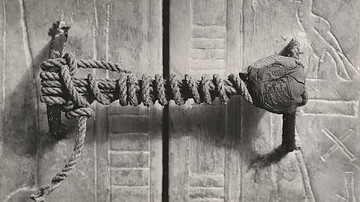Review

| Rating: | |
|---|---|
| Title: | Reception of Cleopatra in the Age of Mass Media, The (IMAGINES – Classical Receptions in the Visual and Performing Arts) |
| Author: | Gregory N. Daugherty |
| Audience: | General Public |
| Difficulty: | Medium |
| Publisher: | Bloomsbury Academic |
| Published: | 2022 |
| Pages: | 246 |
Gregory N. Daugherty provides a sweeping analysis of how popular media has molded Cleopatra's image to suit American appetites. This book is a broad and well-researched introduction to the evergreen subject of Cleopatra's portrayal in the pop culture of the United States. Students and scholars of media studies and Classics will find this work especially useful.
The first chapter acknowledges the impact that Roman literature had on European portrayals of Cleopatra as an immoral outsider. In the Renaissance and early modern period, writers and painters associated Cleopatra with foreignness, murderous tendencies, and aggressive sexuality. This European literary and artistic tradition formed the basis of the early American reception of the Classics.
From the second chapter onwards, the evolution of Cleopatra's image in American media is outlined in chronological order. Here, the book excels at demonstrating how broader cultural and economic trends shaped American expectations of Cleopatra. The silver screen brought the Egyptian queen to life as one of the iconic "femme fatales" of silent film in the 1910s. As the "bad girl" archetype became less popular with American audiences, this version of Cleopatra slowly died out in favour of more relatable characterizations.
Around the turn of the century, Cleopatra became a mascot for hygiene and beauty brands. These brands emphasized Cleopatra's glamour and beauty to appeal to women consumers. Daugherty posits that this development contributed to a more sympathetic view of Cleopatra in American media. She became a stand-in for the "New Woman", who was more sexually and economically liberated than previous generations. This kinder, more flattering Cleopatra grew in popularity over the first half of the 20th century.
Daugherty rightly marks the next major milestone in Cleopatra's reception as Elizabeth Taylor's anachronistic 1963 film, which had a profound and long-lasting impact on global pop culture. His analysis of Cleopatra spreads out to cover modern television, novels, music, and video games. He argues that the 21st-century American media has shifted to a new image of Cleopatra, one built around a sense of historical authenticity. While not necessarily more accurate than films of the post, TV series like HBO's Rome create a feeling of realism that leaves audiences satisfied. This book also examines fantasy and science fiction, where depictions of Cleopatra are less obliged to sell audiences on their authenticity.
These fictional Cleopatras – from the 19th century to the present – have relied on long-standing myths to build her character. The popular image of Cleopatra as a seductive "man-eater" has inundated Western culture. Modern racial labels have also dogged her reception in the Western canon. The historical Cleopatra was of mostly Greek and West Asian descent, with only a possibility of Egyptian ancestry. Her portrayal as both a Greek and an "Egyptian" placed her in an ambiguous position between "White" and "Black" in late Medieval and early modern Europe. For this reason, American anxieties over race and sexuality have often been acted out through Cleopatra's portrayals in epic, comedic, and pornographic films.
At the time of this review, there is no other monograph that deals with Cleopatra's modern reception as broadly as this one. The author, Gregory N. Daugherty, is Professor Emeritus of Classics at Randolph-Macon College. He has published work on Classical Greece and Rome, as well as the reception of antiquity in modern pop culture.
Hundreds of endnotes allow readers to follow up on the book's references to popular culture and scholarly works. Illustrations from postcards, film stills, and advertisements allow readers to visualize Cleopatra's transformations over time. At the end of the book are lengthy bibliographies for topics such as Cleopatra in film, comic books, literature, and video gaming. Other resources include a detailed index and timeline of the historical Cleopatra's life.
About the Reviewer
Cite This Work
APA Style
King, A. (2023, June 19). The Reception of Cleopatra in the Age of Mass Media. World History Encyclopedia. Retrieved from https://www.worldhistory.org/review/369/the-reception-of-cleopatra-in-the-age-of-mass-medi/
Chicago Style
King, Arienne. "The Reception of Cleopatra in the Age of Mass Media." World History Encyclopedia. Last modified June 19, 2023. https://www.worldhistory.org/review/369/the-reception-of-cleopatra-in-the-age-of-mass-medi/.
MLA Style
King, Arienne. "The Reception of Cleopatra in the Age of Mass Media." World History Encyclopedia. World History Encyclopedia, 19 Jun 2023, https://www.worldhistory.org/review/369/the-reception-of-cleopatra-in-the-age-of-mass-medi/. Web. 17 Apr 2025.




